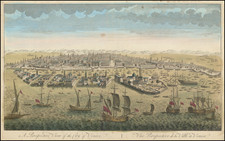Venetia, an original antique bird's-eye view by Matthaus Merian, was printed in Frankfurt in 1636, and stands as an iconic representation of Venice in the 17th century. This detailed rendering captures not only the intricate network of canals and the distinguished architecture of the city, but also the surrounding lagoon, outer islands, and contiguous coastline, weaving a comprehensive picture of the city's geography and urban fabric.
The 17th century marked an era of significant cultural and economic prosperity for Venice, where it served as a pivotal maritime power and a nexus of art, commerce, and diplomacy. With its strategic location, the city was at the heart of Mediterranean trade routes, and this map captures the vibrancy of this bustling metropolis. Venice's Grand Canal, a major thoroughfare for vessels ranging from sailing and merchant ships to smaller boats and gondolas, emerges as a central figure, demonstrating the city's unique blend of architectural splendor and nautical activity.
With keen precision, Merian depicted prominent Venetian landmarks such as St. Mark's Basilica, the Doge's Palace, and the Rialto Bridge. The islands of the Venetian Lagoon—San Giorgio, Murano, Burano, Torcello, among others—are also illustrated, highlighting Venice's expansion and the importance of these satellite settlements. Notably, the inclusion of the Venetian Republic's coat-of-arms, crowned by the Doge's cap and accompanied by the iconic Venetian Lion of St. Mark, anchors the map with a distinct emblem of the city's governance and authority.
In the broader European context, this map serves as a testament to Venice's grandeur and significance during a period marked by exploration, diplomacy, and cultural exchange. As a cartographic masterpiece, Venetia not only illuminates the city's geographical intricacies but also echoes the spirit of an age when Venice was a lustrous jewel in the Mediterranean's crown.
Mathaus Merian (1593-1650) was the father of engraver Matthäus the Younger, and of the painter, engraver, and naturalist Maria Sibylla Merian. He was born in Basel, Switzerland and trained in engraving in Zurich. After a time in Nancy, Paris and Strasbourg, he settled in Frankfurt. While there, he worked for Johann Theodor de Bry, the publisher and son of the travel writer. In 1617, he married Maria Magdalena de Bry, Johann Theodor’s daughter. In 1623, Merian took over the de Bry publishing house upon the death of his father-in-law. Merian’s best known works are detailed town views which, due to their accuracy and artistry, form a valuable record of European urban life in the first half of the sixteenth century









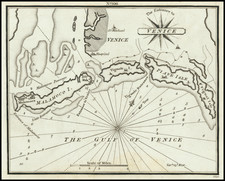
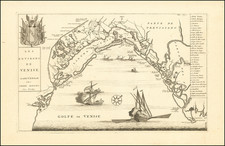
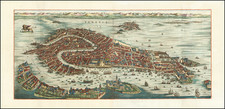
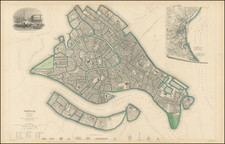
![Piazza San Marco, Venice] Vue perspective de la superbe place de St. Marc à Venise](https://storage.googleapis.com/raremaps/img/small/90174.jpg)
